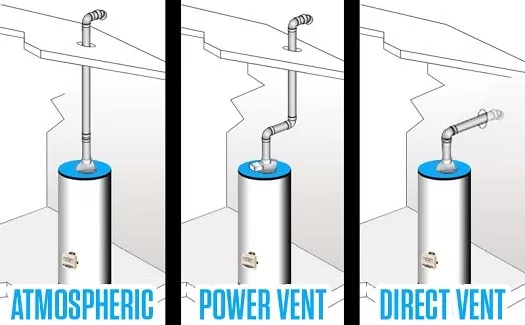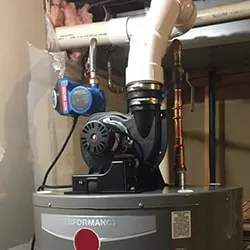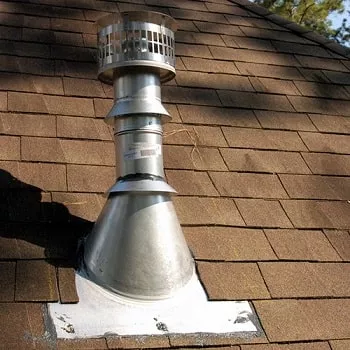When installing a gas-fueled water heater in your home, you're going to think through the project before you tackle it. One primary consideration is, what are your gas water heater venting options? We'll cover each venting type individually, as well as requirements and some potential water heater venting problems that you may find.
Wate Heater Vent Types

There are two components to venting. Your water heater needs to exhaust flue gases safely, and it must also draw fresh air indin. Because the exhaust includes carbon dioxide, it must vent outside. Here are your three options:
- Atmospheric vent
- Power vent
- Direct vent
Atmospheric
If you have an atmospheric venting system, your exhaust vents naturally. What this means is that because of its buoyancy, the exhaust will escape through a vertical pipe, often into a chimney where it can then leave the home for good. The air used for combustion draws from the atmosphere inside of the house (or garage). Atmospheric is the most common gas water heater venting option. The main problem with atmospheric vent systems is that they are susceptible to back drafts (more on that later).
Power

If you have a power-vent configuration, it means that your water heater uses a mechanical fan to move air. A few advantages here are that you can vent either vertically or horizontally, and you can install the water heater a considerable distance from the termination point (usually as much as 150'). You can install this type in homes with no chimney.
Whether or not you have a tank or tankless water heater, you need to vent with stainless steel or metal pipe because of the high temperatures. The only way to avoid this is with a condensing unit, which will allow you to vent with PVC.
Direct
With direct vent installations, there is a sealed combustion chamber and a flue pipe. They can vent separately or together through a double-wall pipe. Compared to atmospheric, direct-vent water heaters offer more installation flexibility because they can vent horizontally. They also operate more quietly than their power-venting counterparts.
For more general inquiries about water heaters, you may want to check out this Wikipedia page.
Gas Hot Water Heater Venting Problems
One problem you need to avoid is back-drafting. You see this most commonly with atmospheric configurations, and it means that your exhaust isn't leaving the home. Back-drafting is usually the result of an inadequate vent design. Look for the signs:
- Corrosion at the top of the water heater
- Melted plastic at the top, near the draft hood
- Condensation
You can also run a manual test. Isolate the water heater by closing doors and windows, shutting off the furnace, and letting the water heater run solo. If you feel warm air near the draft hood, then your system is back-drafting.
Water Heater Venting Requirements

The trick is to provide the right amount of size, height, and draft in your ventilation. Here a list of some bare minimum requisites but do not accept this as comprehensive. You will need to review all local and state codes that apply to you and observe them.
- When venting vertically through the roof, you must often use a vent connector. Please be aware that it must have a rise of 1/4" per 12" of horizontal run. It's not much of a slope, so compliance isn't usually that difficult. The total horizontal distance cannot be more than 75% of the vertical distance.
- Typically, B-Vent chimney pipe requires 1" clearance, but there is zero-clearance pipe available. For a single-wall pipe, you need 6" clearance, and you cannot pass it through a ceiling, floor, or wall unless it's masonry or concrete (non-combustible).
- For the draft hood connection, you need to allow for at least 12" of vertical vent before throwing an elbow fitting in the line.
- If you have a power vent water heater, do not share the flue with other appliances.
Check Out Other Helpful Guides
Related resources:
Lighting a Gas Water Heater in 7 Steps
Gas Water Heater Installation
Water Heater Thermocouple Replacement in 5 Steps
How to Clean Thermocouple On Water Heater
How to Turn On Hot Water Heater



